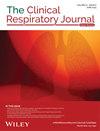Evaluation of PD-L1 Expression in Patients With Non–Small Cell Lung Cancer Using DCE-MRI Quantitative Analysis
Abstract
Purpose
The aim is to evaluate the expression of programmed death ligand 1 (PD-L1) in patients with non–small cell lung cancer (NSCLC) using quantitative perfusion parameters based on dynamic contrast-enhanced magnetic resonance imaging (DCE-MRI).
Methods
A total of 35 patients with a confirmed diagnosis of NSCLC and sufficient tissue pathology were enrolled in the study. The immunohistochemical (IHC) results were used as the gold standard to determine the thresholds for grouping the patients. The patients were divided into three categories based on their PD-L1 expression: (1) PD-L1-negative (IHC < 1%) and PD-L1-positive (IHC ≥ 1%); (2) PD-L1 weak (IHC < 50%) and strong expression (IHC ≥ 50%); and (3) PD-L1 nonexpression (IHC < 1%), low expression (IHC between 1% and 49%), and high expression (IHC ≥ 50%). DCE-MRI datasets were analyzed to acquire histogram parameters, including mean value, uniformity, skewness, kurtosis, entropy, energy, and quantity, of quantitative perfusion parameters using the extended Tofts model (ETM) and the exchange model (ECM). Subsequently, the parameters were compared between the aforementioned groups.
Results
IHC showed PD-L1 < 1% in 20 cases, PD-L1 (1%–49%) in 14 cases, and PD-L1 ≥ 50% in 14 cases. At a threshold of 50%, statistically significant differences were observed for ETM/Ktrans (Q25 and Q50), ETM/Kep (Q10), and ECM/Ve (Q75 and Q90), with values being higher in the weak PD-L1 expression group. With thresholds of 1% and 50%, the results of the pairwise comparison showed that the ECM/Ve (Q75) value in the low PD-L1 expression group was significantly higher than that in the high PD-L1 expression group.
Conclusion
DCE-MRI quantitative analysis is a valuable tool for the evaluation of PD-L1 expression in NSCLC. It provides a noninvasive method that can be employed as an adjunctive technique for the stratification of PD-L1 expression in patients with NSCLC.


 求助内容:
求助内容: 应助结果提醒方式:
应助结果提醒方式:


